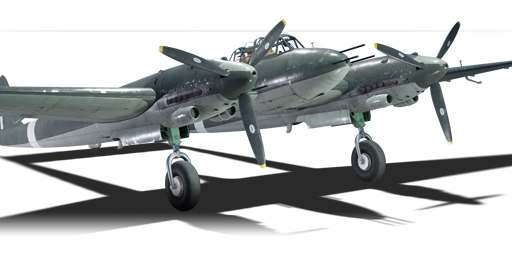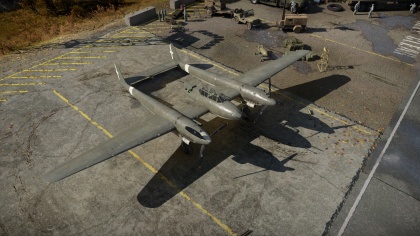SM.91
Contents
Description
The SM.91 is a rank II Italian attacker
with a battle rating of 3.7 (AB/RB) and 4.0 (SB). It was introduced in Update 1.85 "Supersonic".
General info
Flight performance
The SM.91 fulfils a similar role to the P-38 when flown as an interceptor: a twin-engined fighter that is surprisingly capable as a dogfighter due to its good turn rate, especially when spaded. The twin Piaggio P.XI RC.40 12 cylinder inline engines, which happen to be a pair of the powerful DB 605 Inverted V12 engines, are placed away from the cockpit, meaning its hard to take them out in a head-on. However, the heavy nature of the plane means that its acceleration is quite sluggish at low altitudes. The aircraft also sports leading edge wing slats that shorten the turning circle and has airbrakes that can help it slow down in a dive and help when landing on an airfield, which is already fairly easy due to its tri landing gear.
| Characteristics | |||||||
|---|---|---|---|---|---|---|---|
| Stock | |||||||
| Max Speed (km/h at 7,010 m) |
Max altitude (meters) |
Turn time (seconds) |
Rate of climb (meters/second) |
Take-off run (meters) | |||
| AB | RB | AB | RB | AB | RB | ||
| 561 | 546 | 9500 | 21.1 | 21.9 | 9.3 | 9.3 | 300 |
| Upgraded | |||||||
| Max Speed (km/h at 7,010 m) |
Max altitude (meters) |
Turn time (seconds) |
Rate of climb (meters/second) |
Take-off run (meters) | |||
| AB | RB | AB | RB | AB | RB | ||
| 610 | 585 | 9500 | 19.0 | 20.0 | 15.3 | 12 | 300 |
Details
| Features | ||||
|---|---|---|---|---|
| Combat flaps | Take-off flaps | Landing flaps | Air brakes | Arrestor gear |
| ✓ | ✓ | ✓ | ✓ | X |
| Limits | ||||
|---|---|---|---|---|
| Wing-break speed (km/h) |
Gear limit (km/h) |
Combat flaps (km/h) |
Max Static G | |
| + | - | |||
| 600 | ~9 | ~4 | ||
| Optimal velocities | |||
|---|---|---|---|
| Ailerons (km/h) |
Rudder (km/h) |
Elevators (km/h) |
Radiator (km/h) |
| < 280 | < 200 | < 450 | > 380 |
| Compressor (RB/SB) | ||
|---|---|---|
| Setting 1 | ||
| Optimal altitude | 100% Engine power | WEP Engine power |
| 5,800 m | 1,232 hp | 1,387 hp |
Survivability and armour
Examine the survivability of the aircraft. Note how vulnerable the structure is and how secure the pilot is, whether the fuel tanks are armoured, etc. Describe the armour, if there is any, and also mention the vulnerability of other critical aircraft systems.
Armaments
Offensive armament
The SM.91 is armed with:
- 3 x 20 mm MG 151/20 cannons, nose-mounted (300 rpg = 900 total)
- 1 x 20 mm MG 151/20 cannons, chin-mounted (300 rpg)
- 2 x 20 mm MG 151/20 cannons, wing-mounted (300 rpg = 600 total)
The SM.91 has 6 of the powerful MG 151/20's mounted in the centre of the aircraft and can utilise the minengeschoss round. Use "Stealth" or "Air targets" belts for best effectiveness.
Suspended armament
The SM.91 can be outfitted with the following ordnance:
- Without load
- 6 x 50 kg GP 50 bombs (300 kg total)
- 6 x 100 kg GP 100 bombs (600 kg total)
The SM.91 can carry up to 6 x 100 kg bombs, which makes it useable in ground forces battles. Due to the rather small size of the bombs, you have to be extra accurate when dropping bombs.
Defensive armament
The SM.91 is defended by:
- 1 x 20 mm MG 151/20 cannon, dorsal turret (350 rpg)
The SM.91 can defend itself very well from any tailing aircraft. Use "Universal" belts for the most effective defensive fire.
Usage in battles
When flying it as an interceptor, it can shred bombers apart with its powerful armament and can ward off escorts who try to tail it with its single 20 mm cannon. However, it is paramount that you come in from oblique angles when attacking bombers, as their gunners can easily take out your pilot due to your lack of armour and bulletproof glass.
When flying it as a ground attacker, be wary that carrying the max payload will significantly decrease performance and you will be a prime target for low flying fighters like Yak's and Spitfires. However the maximum payload is rather weak, only 6 x 100 kg bombs with a max armour pen value of 91 mm and a blast radius of 4 meters. This means that you must land a near perfect or direct hit on medium and heavy tanks in order to destroy them.
Manual Engine Control
| MEC elements | ||||||
|---|---|---|---|---|---|---|
| Mixer | Pitch | Radiator | Supercharger | Turbocharger | ||
| Oil | Water | Type | ||||
| Not controllable | Controllable Not auto controlled |
Controllable Not auto controlled |
Controllable Not auto controlled |
Separate | Not controllable 1 gear |
Not controllable |
Modules
| Tier | Flight performance | Survivability | Weaponry | ||
|---|---|---|---|---|---|
| I | Fuselage repair | Radiator | Turret 20 mm | MCGP50 | |
| II | Compressor | Airframe | New 20 mm cannons (turret) | ||
| III | Wings repair | Engine | Offensive 20 mm | MCSAP100 | |
| IV | Engine injection | Cover | New 20 mm cannons | ||
Pros and cons
Pros:
- 6 x 20 mm MG 151 in the centre of the aircraft
- Main armament has an insane ammo capacity
- Gets an attacker spawn (AB/RB)
- 20 mm MG 151 turret in the back
- Surprisingly good turn rate
- Can act as a powerful interceptor
- Made entirely out of metal, so it can take some punishment.
- Fuel tanks are self-sealing
Cons:
- No armour protection
- Big target
- Lack of bulletproof glass means pilot is susceptible to getting knocked out, especially in head-ons
- Wings are littered with fuel tanks
- Carrying the largest payload has a noticeable effect on performance
History
In 1942, Regia Aeronautica requested a new, long range aircraft that was to be powered by the German DB 601 Inline Inverted V12, carry an 800 kg bomb load, have 6 x 20 mm main armament and a single 20 mm rear cannon. Savoia-Marchetti had previously worked on the SM.88 heavy fighter and the request for a long range fighter disqualified the 88, as it only had a 1,250 L fuel capacity. SM started to work on a new fighter named the SM.91 that was made entirely out of metal, had 6 x 20 mm MG 151 cannons (7 if you count the rear gunner) provided by Germany, was powered by two DB 605 engines and had a range of 1,600 km with a 1,600 L fuel capacity that could be enlarged to 1,800 L with auxiliary tanks.
The two prototypes that were produced made their maiden flight on the 11th of May, 1943 and logged 27 hours at Vergiate. However, it was never entered into the official trials, mainly due to it still being in testing. The first prototype was captured and sent to Germany, and the second prototype was presumed to have been destroyed by bombers.
Media
Excellent additions to the article would be video guides, screenshots from the game, and photos.
See also
Links to the articles on the War Thunder Wiki that you think will be useful for the reader, for example:
- reference to the series of the aircraft;
- links to approximate analogues of other nations and research trees.
External links
Paste links to sources and external resources, such as:
- topic on the official game forum;
- encyclopedia page on the aircraft;
- other literature.
| Savoia-Marchetti | |
|---|---|
| Bombers | S.M.79 serie 1 · S.M.79 serie 8 · S.M.79 AS · S.M.79 bis/T.M |
| S.81 | |
| Attackers | SM.91 · SM.92 |
| Export | S.M.79 B |
| Captured | ▀S.M.79 serie 1 · ▀S.M.79 serie 4 · ▀S.M.79 serie 8 |
| ▀S.M.79 AS · ▀S.M.79 bis/N · ▀S.M.79 bis/T.M · ▀S.M.79 B | |
| Italy strike aircraft | |
|---|---|
| Ba.65 (K.14) L · Breda 88 (P.XI) · F.C.20 Bis · P.108A serie 2 | |
| Ro.57 Quadriarma · SM.91 · SM.92 | |
| Hungary | ◐Bf 110 G-4 · ◔IL-10 |
| Romania | Hs 129 B-2 (Romania) |





